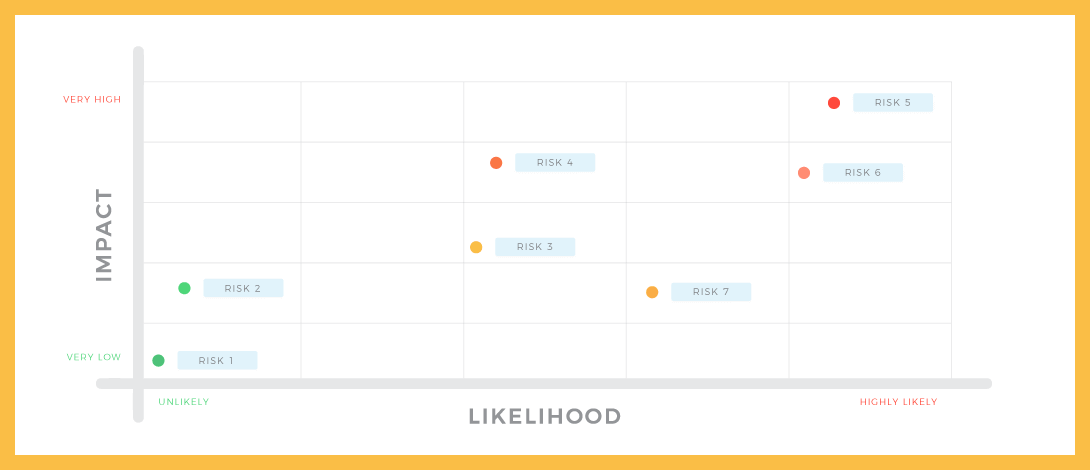Murphy’s law honors the inevitable.
And whether you are a patron or disciple of the law or not, you have to accept the value of contingency planning which guarantees the continuity of your business/project and ultimately lowers and minimizes the impact on your bottom line.
When managing projects, one of the most important factors is analyzing potential project management problems with a risk assessment matrix.
How amazing would it be to have automated risk identification and analyses? Yes, there are loads of options out there but we are going to do a deep dive into an amazing new app – nTask.
Pro Tip: Signup for the Best Risk Management Software to create Risk Matrix. Join nTask today, to manage your risks, issues, projects, and tasks!
We will cover in Risk Assessment Matrix:
- What is the Risk Assessment Matrix?
- How to Create Risk Assessment Matrix (Steps)?
- nTask Risk Assessment Matrix
- Risk Efficiency Measurement
What is Risk Assessment Matrix?
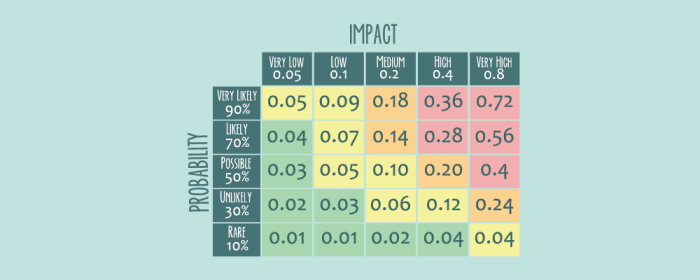
A Risk Assessment Matrix, also known as a Probability and Severity risk matrix, is designed to help you minimize the probability of potential risk to optimize project performance.
Essentially, a Risk Matrix is a visual depiction of the risks affecting a project to enable companies to develop a mitigation strategy.
As the aforementioned ‘Management Expert’, Murphy so pithily observed, things will go awry, and when they do the bottlenecks created in projects impact the bottom line not to mention the delivery timelines. While most project managers may run around trying to identify and work out risks. Today’s smart project managers turn to nTask to create a Risk Matrix so easily that when I created my first one, I actually sat back in awe.
There it was, normally the bane of my life, especially at the onset of a project, so easily done that I couldn’t quite accept its validity. Yes, I will admit, I went through a few iterations to make sure something this easy was still plausible and logical.
Those of you, who like to create and use Risk Matrices will know the Benefits of a Risk Assessment Matrix, but for the newbies or those looking to refresh their knowledge, let’s find out.
Learn what is Strategic Risk Management:
Strategic Risk Management to Gain Success in the Organizational Paradigm
Benefits of a Risk Assessment Matrix
When used correctly, a risk matrix will
- Identify event outcomes that should be prioritized or grouped for further investigation
- Provide a good graphical portrayal of risks across a project/task
- Simplifies the risk management process
- Help to identify areas for risk reduction
- Provide a quick and relatively inexpensive risk analysis
- Enable more detailed analysis to be focused on high-risk areas
How to Create a Risk Assessment Matrix?
There are some fundamental steps needed to achieve successful risk management for projects using the risk assessment matrix.
Step 1: Risk Identification
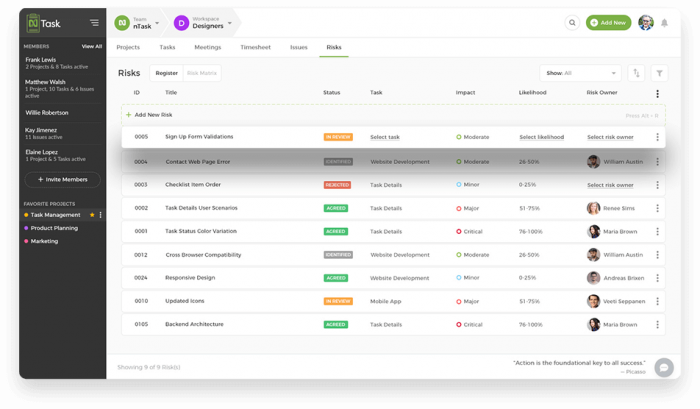
Defining and identifying the risks associated with a project is the initial phase in risk control. The scope of the project and task is an indication of a proactive approach to limit damages as much as possible. Pinpoint as many risks as you can to gain various perspectives. Brainstorming with the project team to acknowledge events such as fire, theft, flood, refunds, refusal by vendors, or any uncertain business situation.
Some companies develop checklists from previous experiences of past projects for risk identification to manage risks. These checklists are essentially developed to identify potential risks associated with each new project.
You might be asking ‘what happens after the risks are identified?’ A key process of risk management called ‘Risk Analysis’ begins.
Some considerations for project risk identification include:
- Project scope statement
- Cost management plan
- Human resource management plan
- Stakeholder register
- Activity cost estimates
- Project documents
Step 2: Risk Analysis
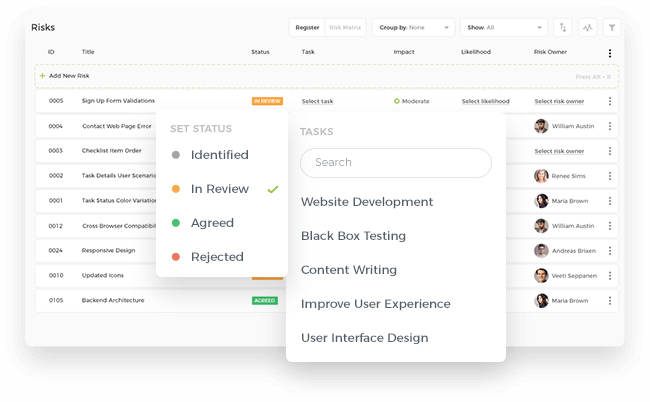
The real business of project risk management starts with risk analysis. After the project team has described all the potential risks, the next step is to evaluate them. nTask’s built-in Risk Assessment Matrix, automatically populates the fields to create a matrix.
This matrix can then be used to assess risk levels. Ideally, this should be done with all stakeholders using real data to support the matrix. During this session, all stakeholders need to accept and agree to the risks in order for a contingency plan to be put in place.
You will need to analyze the expected damage that risk can make and come up with strategies on how to reduce its impact. The best thing is to have a meeting with the stakeholders and show them real data analysis. It’s imperative to thoroughly examine each and every factor associated with them and their possibility of occurrence for designing a strategy that will be apt in tackling them.
Overall, project managers adopt an eagle-eyed approach to risk analysis and that is why every risk component is examined to develop a roadmap for risk resolution.
Step 3: Assessing Risk Impact Level
Here you will need to assess the impact level of the project risk. You have to identify if the risk impact is minor or critical for your project. This will help in minimizing the risk and gives you a clear direction to complete the project as planned.
The nTask risk assessment matrix involves weighing probabilities against the impacts of risks when they occur. The outcomes of such evaluation help classify risks according to the most severe and the less critical. In the risk table, you will see how high-risk and low-risk factors are displayed in the grids.
Step 4: Risk Prioritization
nTask risk assessment matrix shows how project risks are prioritized for at different levels. Project risk assessment is a continuous process and needs to change concurrently with modifications in your organization or with consumer trends. If the matrix is reviewed only once a year, developing risks may be overlooked, leading to issues down the line.
1. Critical/High Priority Risks:
These risks require prompt responses and quick action. They are designated high priority because they need to be addressed swiftly. Critical risks are intensified to meet a deadline, resolve an error, or deliver an MVP timely.
2. Major Risks:
These are also classified as High Risks, but at comparatively low-risk compared to the extreme designation in the probability and severity risk matrix. Major/High risks are denoted by “H,” and have a unique color code like every other related cell in the matrix.
3. Moderate Risk:
These risks are tagged with mid-level risks. They are not a high priority and are not known to be used to develop a mechanism to resolve bottlenecks throughout the lifespan of a progressing project. This risk classification serves to help managers work around time constraints or perfect the quality of the project deliverables.
4. Minor risks:
These risks are of low weight. They are not of big concern but that doesn’t mean that they are not important. It’s just that the team can get to them after the rest of the risks have been mitigated.
nTask Risk Assessment Matrix
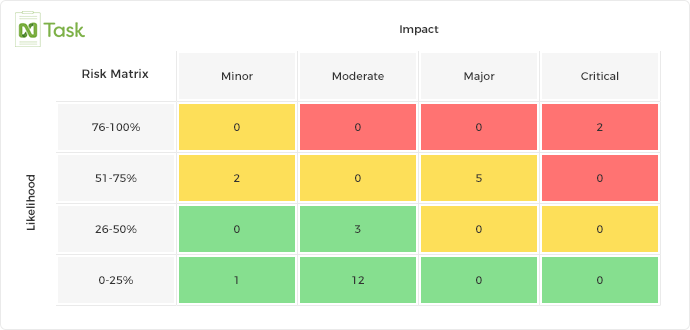
nTask enables you to generate a risk assessment matrix designed to provide flexible risk reporting for well-informed decision-making.
The risk matrix excel comprises a grid, with the Likelihood or Probability of Occurrence at the Y-axis and the resultant Risk Impact on the X-axis. These two components are developed to represent the actual nature of risk.
The probability is visualized and can be expressed as a percentage, whereas the severity is expressed in terms of probable impact.
The risk component of the risk assessment matrix is placed in appropriate matrix slots called “Cells,” with its function is to show with the probability of the resulting risk outcome.
At nTask, risks are assessed on the basis of severity. The color code is assigned to them by default. A moderate risk can get a ‘Red’ color, just as a high priority risk if the system determines that this risk has serious consequences. For example, if you are aware of the likelihood of severe technical difficulty hindering a project, then this kind of risk gets the “Critical” designation. Critical risk also expresses the likelihood of severe injuries, potential damages, and financial loss.
“Minor” indicates that little attention is required as the risk has a low probability of occurring.
You can use nTask conveniently by creating an account for FREE, to get a hang of how risk assessment matrix works. We have very unique and interesting risk management features to help you run successful projects using risk mitigation plans.
Risk Impact (Risk Severity)
In nTask, risk impact occurs in 4 levels:
- Minor (Blue)
- Moderate (Green)
- Major (Orange)
- Critical (Red)
Risk Likelihood
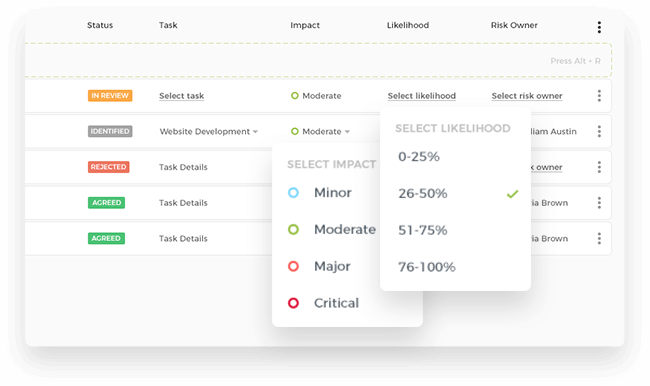
This is the possibility of the occurrence of risk in your projects. nTask Risk likelihood is split into four ranges of percentages:
- 0-25% – less likely to occur
- 26-50% – occasional
- 51-75% – likely to occur
- 76-100% – likely to cause serious problems
Risk Zones
Apart from these divisions, there are three major zones inside the matrix as well. After the calculations are done, the quantified risk falls into these three zones:
- Yellow – an acceptable low-risk zone
- Green – a moderate risk zone that may not be acceptable
- Red – a critical zone that is high risk and unacceptable
These zones make the result of a risk matrix more transparent by giving out a clear-cut division regarding the future steps that need to be taken.
Risk Status
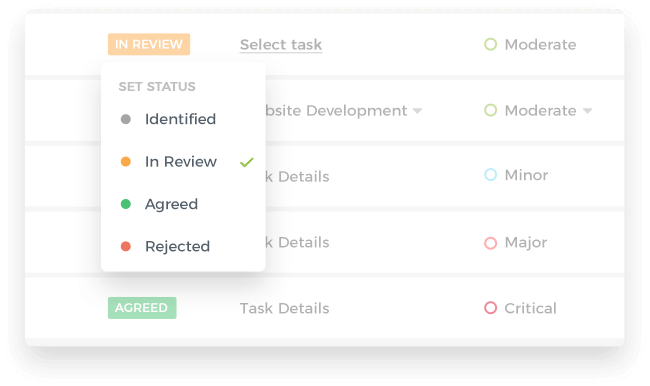
It is easy to track the status of the risk within nTask application. The preset risk statuses are:
- Identified
- In-Review
- Agreed
- Rejected
Risk Efficiency Measurement
Risk Audit

This audit is an independent measurement of the risks with recommendations to increase the effectiveness of risk management being performed in the company. This audit evaluates:
- Exhaustiveness and granularity of risks being identified by the experts in the company
- How good are we at identifying risk that is being discovered in the company?
- Linkage of project risks to organizational risks
- Effectiveness of mitigation or contingency plan put into action by the company
This audit is generally performed by the independent technical experts from the market that are the judges of the way, the risk management principles are being applied in a certain company. The key elements of this audit are:
- Identify areas of importance for risk analysis for a project
- Potential additional risks identified based on the review
- Customized checklist to evaluate the risks of a project
- Risk radar – risk-prone areas of the product group
- Top 10 risks in the organization from key projects, which requires management attention
Risk Metrics
The most important risk analysis is done by monitoring the risk metrics throughout the project closure procedure. All of the details that we receive from this review are the lessons learned which we can use in the future to tackle many problems related to risk:
- Number of risks that occurred during the project closure
- Number of risks that were identified during the project closure
- Was the impact of the risks as severe as originally thought or was it a minor risk that could have been ignored from the start of the project?
- How many risks recurred during the entire lifetime of the project?
- How do the actual problems and issues faced in a project differ from the anticipated risks that the project might have experienced in its lifetime?
Risk Matrix for Risk Management
You might have heard of the quote, ‘The greater the risk, the greater is the potential reward’. If you don’t take any risk to step out of your comfort zone, you’ll never improve your current position.
But that doesn’t mean there is no need for proper risk management. Without it, you can possibly create havoc in your organization and can be met with some unforeseen circumstances whose control will not be in your hands. This can be tackled perfectly with Risk Assessment Matrix.
Utilizing risk matrix for risk management will not only reduce the likelihood of the risk but will reduce the magnitude of its impact on operations as well. It provides timely data that quantify the threats and greatly facilitates the organization to take some coherent steps for decreasing the potential chaos that might occur in case of ambiguity.
The numerical values in the risk matrix provide a powerful way to depict the company’s exposure to risks and how much effort is needed to minimize them. They make the entire situation clear by making use of each division inside the matrix and give insights regarding the future approaches that need to be adopted.
Do Risks Keep You Up at Night?
As a project manager, do you contemplate handling risks and their eventual impact on a project timeline? If so, it is best to create a risk assessment matrix and incorporate it within a project management software at your company.
Having a clear vision of the risks in any company is a life-changing experience. You can’t turn a blind eye toward them. Some project managers procrastinate and try to handle risks the old fashion way – i.e. according to the ‘Just do it’ management principle. Things have changed these days and it is better to adapt to new strategies instead of sticking with the old ones.
Things have changed these days and it is better to adapt to new strategies instead of sticking with the old ones.
Besides, we have matrices for everything, don’t we?
A risk assessment matrix, or simply a risk matrix, may change the way these old-fashioned managers get things done. Technology does bring change in people.
Look at your parents or grandparents for that matter. A decade ago, they were against the excessive use of computers. And now, they cannot spend an hour without their smartphones.
Therefore, if you are one of those guys or you happen to someone reluctant to give up the old methods, a little tech always helps.
Everyone loves keeping things in control and they fear what they don’t know.
If managers can somehow understand the concept of risk assessment and how to minimize it, they will do it with more interest. The reason behind this is that it is quite an accomplishment to save the company from potential risks. Makes you feel like a hero.
You will be better equipped to face it
Let’s get one thing straight; the risk is pretty much inevitable.
However, it is not something that you can’t alleviate. You can use any method you deem fit. But know this; intuition and gut feeling do not work every time.
That is why ad hoc methods are a thing of the past. The best kind of planning is pre-planning. Using a risk matrix will increase your chances of minimizing, if not completely avoiding, various types of risks.
What are risk assessment matrix examples?
Risk assessment matrix examples are visual tools used to identify, assess, and prioritize risks. They can be used to understand the potential consequences of each risk and establish a plan for dealing with them. The primary benefit of risk assessment matrices is that they give a clear structure for evaluating risks and displaying their severity.
The exact format of a risk assessment matrix varies from organization to organization, however many of them use different colors or numbers to denote the level of the potential impact associated with each issue (e.g., green for low-impact issues and red for high-impact ones). Typically, an initial screening process will determine which risks actually require further evaluation in the form of questionnaires or surveys asking how likely an event is, what could be done if it were to occur, etc.
Effective team management strategies for remote workplaces?
1. Develop clear goals and expectations: It is important to establish clear goals and expectations with each team member before beginning a project. This should include deadlines, desired outcomes, and any other specifics related to the project. Be sure to document these expectations so that everyone is aligned on the same page.
2. Communicate regularly: Regular communication is essential in order for remote workers to stay connected and up-to-date on progress or changes in direction of a project or tasks that need immediate attention. Establishing virtual meetings or video calls can be helpful in creating a sense of connection between team members as well as providing an opportunity for collaboration and brainstorming ideas together.
3. Set up shared workspaces: Sharing files online can help keep all relevant documents organized in one place so that everyone has access to them at any time from anywhere in the world – this could also streamline workflow processes and save time spent shuffling through emails back-and-forth trying to find information someone needs urgently.
FAQ’s
What are some good team management tips to improve mental health?
– Encourage listening to, understanding, and respecting each other’s perspectives as well as finding common ground for effective collaboration.
– Create an open dialogue between team members, allowing them to express their needs and concerns in order to maintain healthy interpersonal relationships within the workplace.
– Focus on achievements rather than purely results in order to motivate the team’s mental health by providing positive reinforcement when goals are met or surpassed and emphasizing the importance of working together towards a common goal.
What is the most important skill a team manager must possess?
Summing It All Up
The risk assessment matrix comes with plenty of benefits. However, those “benefits” scale according to the software feature, the way your team lead is using the RA model, and the company requirements.
Regardless, these matrices are a great way of strategizing stuff and getting things done fast.
- Risk assessment matrix is a simple methodology.
- Perfect for highlighting and rating risk severity.
- Risk assessment matrices are flexible and offer several systematic approaches to problem-solving.
- ISO 31000 certified methodology.
Moving over to the actual implementation part, the Risk Assessment matrix methodology “CAN” turns out to be a gamble. However, if you are a top-tier project manager, you’d want to even the odds, instead of fearing for the worst.
When you are labeling your Axis, keep in mind that they should be labeled as ‘Likelihood’ and ‘Consequences.’ The reason behind this logic is that ‘Likelihood’ is a subjective term as compared to the conventional: ‘Frequency’ term.
In addition, when you are in the middle of deriving numeric values for each cell in the matrix, there is a very real possibility for these values to be inaccurate. So, always double-check while you are doing the math. The best way of handling this predicament is by numbering the rows and columns of your risk assessment matrix differently.
Overall, this methodology is simple, fast, and reliable. If you are a project manager who wishes to get by with minimum risk or a risk-free workflow, you should try to incorporate a risk assessment matrix in the process.
It’s important to understand that a risk matrix is only a tool, not a complete solution for your needs. It all comes down to the intellectual worth of the people interpreting the matrix’s results. Alternatively, you can use a risk management tool to help you identify and assess the likelihood and probability of risks in your projects.
A carefully sorted-out strategy for risk mitigation always comes in handy in case of unforeseeable events and is a great means to equip the team with an effective contingency plan.
The essence of the story? Risk Management should be a mandatory requirement whenever a new project planning is being done for staying as informed about the risks as possible.

